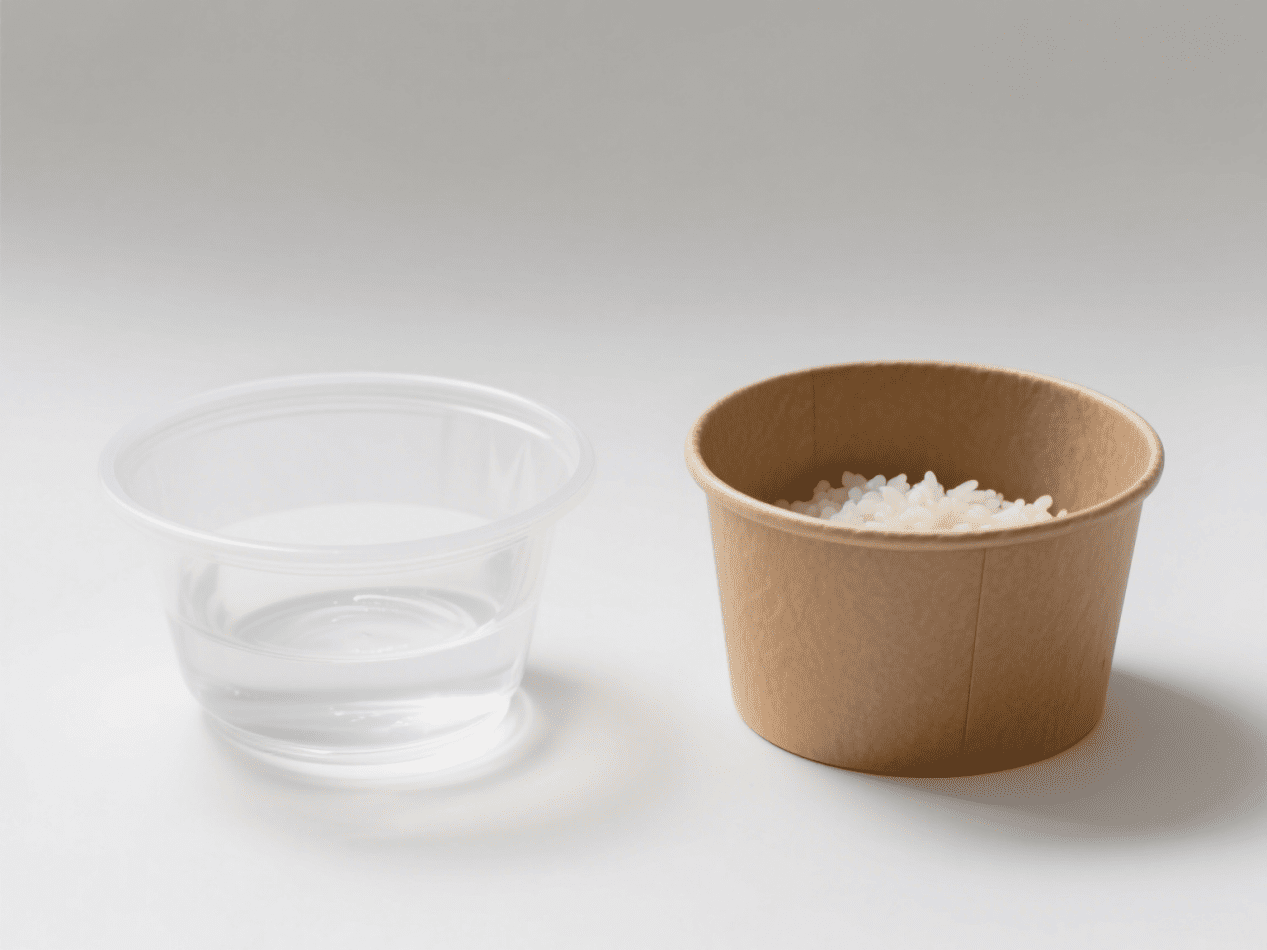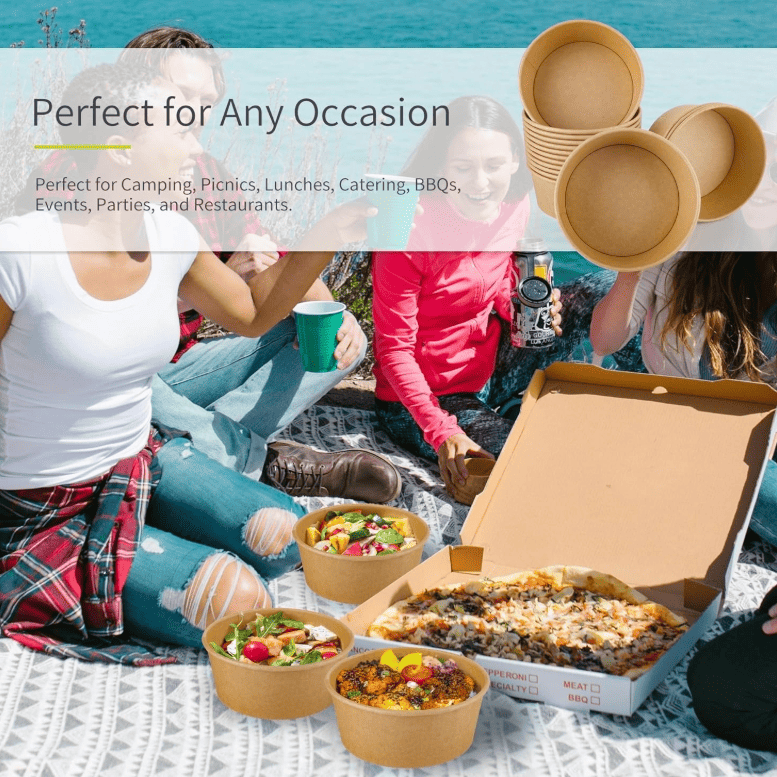Disposable Bowls Safety Guide: Plastic or Paper – Which is Better
Disposable bowls are used a lot in takeout, travel, and events. They are easy to use. They can also have safety, eco, and health risks. Many people worry about chemicals from plastic bowl1s. Some paper bowl2s have “forever chemicals” (PFAS3) in the coating. These issues have made more people pay attention. This guide answers four questions: the risks of disposable bowls4, if plastic bowl1s are safe, if paper bowl2s have PFAS3, and which is better. I also give tips for safer and greener choices.
Buy food-grade products. Do not put hot soup or oily food in bowls that are not made for high heat. This is the best way to lower risk.

I have seen many people use the wrong type of bowl for hot or oily food. This can cause harm. The first step is to choose the right bowl for the right food.
What are the risks of disposable bowls4
Disposable bowls can be paper or plastic. If they are made poorly or used in the wrong way, they can cause harm.
Bad materials, unsafe coatings, and too much heat can release harmful stuff or make waste that lasts.
The main risks are harmful substances moving into food, chemical release5 when hot or oily food is inside, microplastics6 from plastic bowl1s, and waste that does not break down. To avoid these problems, buy safe products7 and use them in the right way.
| Risk type | Cause | Note |
|---|---|---|
| Harmful substance | Bad raw material, unsafe coating | May release BPA or heavy metals |
| Heat release | Hot or oily food in wrong bowl | May release organic compounds |
| Microplastic | Plastic bowl wear or break down | Can build up in the body or in nature |
| Not degradable | Plastic or some coated paper | Hard to break down in nature |
Are plastic bowl1s safe
Plastic bowl safety depends on the material and how it is used.
Food-grade PP is safer. PS and PVC can have more risk, especially with heat.
<sup id=](https://papercupshkl.com/wp-content/uploads/2025/08/%E5%9B%BE%E7%89%8715.png) 1s safety" title="Plastic bowls safety" />
1s safety" title="Plastic bowls safety" />
PP can take heat up to 120°C and is stable. It does not have BPA. PS is brittle and can only take up to about 90°C. Heating PS can release styrene, which is bad for health if used often. PET is clear and good for cold food. It can change shape and release chemicals if heated. PVC is soft but has chlorine and should not be used for food.
| Type | Heat limit | Note |
|---|---|---|
| PP | ≤120°C | Safer for hot food if food grade |
| PS | ≤90°C | Can release styrene when heated |
| PET | Cold food | Good look, but not safe with heat |
| PVC | Not for food | Has chlorine, unsafe with heat |
Do paper bowl2s have PFAS3
PFAS3 are chemicals that block oil and water. They do not break down.
Some paper bowl2s use PFAS3 in the coating. Pick PFAS3-free if you can.
<sup id=](https://papercupshkl.com/wp-content/uploads/2025/08/%E5%9B%BE%E7%89%8716.png) 2s" title="PFAS in [paper bowl](https://papercupshkl.com/are-soup-paper-bowls-environmentally-friendly-2/)2s" />
2s" title="PFAS in [paper bowl](https://papercupshkl.com/are-soup-paper-bowls-environmentally-friendly-2/)2s" />
PFAS3 are used in some food coatings to stop leaks. They can stay in the body and in nature for a long time. They may harm hormones and the immune system. A 2021 test in the USA found that more than half of paper food packs8 tested had PFAS3. To avoid them, choose bowls marked PFAS3-Free or use ones with PE or PLA coating.
| Coating type | PFAS3 risk | Option |
|---|---|---|
| PFAS3 | High | Avoid |
| PE | None | Safe if food grade |
| PLA | None | Eco, compostable, but heat under 90°C |
Which is better – paper or plastic bowl1s
Both have good and bad sides. What you choose depends on the food, the heat, and the eco goal.
PFAS3-free paper bowl2s are safe and green. PP bowls9 take high heat and oil better.

| Part | Paper bowl | Plastic bowl |
|---|---|---|
| Food safety | Safe pulp + coating. Check for PFAS3 | PP is safe, PS/PVC less safe |
| Eco | Can break down or recycle, less footprint | Does not break down easily |
| Heat | 90–100°C for short time | PP can take high heat |
| Leak stop | Coating stops leaks | Stops leaks well |
| Brand look | Eco style, can print | Less style, less eco image |
If you want a green takeout choice, use PFAS3-free paper bowl2s. For hot oily food often, food-grade PP10P bowls](https://papercupshkl.com/are-paper-bowls-safe-for-serving-hot-soup/)%%%FOOTNOTE_REF_9%%% can be better.
How to choose safe bowls
Customers should look for safety marks like FDA, GB 4806, or EU 10/2011.
Do not put hot soup or oily food into bowls that cannot take heat.
Pick PFAS3-Free paper bowl2s when you can.
Shops should buy from safe and trusted makers. They can use PLA-coated paper bowls11s](12](https://papercupshkl.com/are-soup-paper-bowls-environmentally-friendly-2/)2s">https://papercupshkl.com/can-you-put-hot-soup-in-disposable-paper-bowls/)12](https://papercupshkl.com/are-soup-paper-bowls-environmentally-friendly-2/)2s to meet eco laws. Label the bowl with material, heat range, and eco info. This can help customers trust the brand.
| User type | Safe choice tip |
|---|---|
| Customer | Check safety mark. Avoid hot food in weak bowls |
| Shop | Pick safe supplier13, use eco coating, label info |
Conclusion
The safety and eco level of disposable bowls4 depend on the material, the coating, and if they meet safety rules. Good paper bowl2s are best for green brands. For hot oily food, good PP bowls9 are fine. Do not use low-quality bowls with harmful chemicals.
1.Learn which types of plastic bowls are safest for hot or oily foods and how to avoid harmful chemicals in your daily use. ↩
2.Learn how paper bowls compare in safety, heat resistance, and eco-friendliness so you can make healthier, greener dining choices. ↩
3.Learn about PFAS and their implications for health and the environment to make safer choices. ↩
4.Understanding the safety concerns can help you make informed choices about using disposable bowls. ↩
5.Find out how certain conditions can lead to harmful chemical release from plastic bowls. ↩
6.Explore the impact of microplastics on health and the environment to understand their risks. ↩
7.Learn how to identify safe disposable products to protect your health. ↩
8.Learn how PFAS in paper food packs can affect your health and the environment, and discover safer alternatives to protect yourself. ↩
9.Learn why PP bowls are a safer choice for hot and oily foods, and how they compare to other plastics in terms of heat resistance and health safety. ↩
10.Discover why food-grade PP is a safer option for disposable bowls and its heat resistance. ↩
11.Find out about PLA-coated paper bowls as a sustainable option for food service. ↩
12.Discover the risks associated with coated paper bowls to make safer choices. ↩
13.Choosing a safe supplier is crucial for ensuring the quality and safety of disposable bowls. ↩